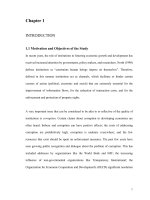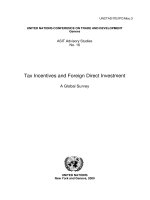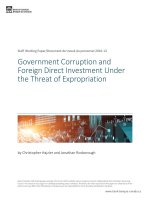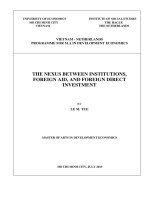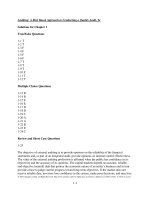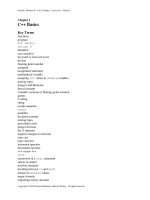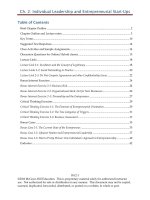Test bank and solution manual interrantaional trade and foreign direct investment (2)
Bạn đang xem bản rút gọn của tài liệu. Xem và tải ngay bản đầy đủ của tài liệu tại đây (415.36 KB, 15 trang )
Chapter 02 - International Trade and Foreign Direct Investment
CHAPTER 2
International Trade and Foreign Direct Investment
Learning Objectives
LO2-1 Appreciate the magnitude of international trade and how it has grown.
LO2-2 Identify the direction of trade, or who trades with whom, and trends in such trade.
LO2-3 Outline the theories that attempt to explain why certain goods are traded internationally.
LO2-4 Explain the size, growth, and direction of foreign direct investment
LO2-5 Explain several theories of foreign direct investment.
NOTE:
International business statistics, data, and facts about countries, regions, governments, and companies
can change rapidly and dramatically. We recommend that you update this information regularly.
As an adopter of this text, McGraw-Hill offers you a complementary online resource each month, the
International Business Newsletter. The IB Newsletter gives you an array of timely and relevant
articles, videos, country profiles, teaching suggestions, and data resources to add breadth, depth, and
richness to the ever-changing topic of international business.
iGlobe is also a way to keep your courses current. In partnership with PBS, iGlobe is a free video
service for McGraw-Hill adopters that allows you to download breaking news videos onto your
desktop to show in class or online. Updated monthly, these streaming videos are complete with
teaching notes and discussion questions. Key concepts for each video are identified to save you time!
Visit www.mhhe.com/ball13e, or talk to your McGraw-Hill sales representative for more information
about iGlobe or the IB Newsletter.
Overview
This chapter addresses three major concerns, the state of international trade, that of foreign
investment, and then an exploration of why businesses enter foreign markets.
International trade and foreign direct investment have grown dramatically over the last three decades.
Although new trading and investment patterns are emerging, developed nations tend to trade with and
invest primarily in other developed nations, and not in developing countries.
Trade theories attempt to explain why nations trade with each other. Mercantilists (1550 to 1800 and
perhaps on-going) believed that trade should be a vehicle for accumulating gold. Adam Smith,
displeased with mercantilist ideas, showed that a nation could acquire what it does not produce by
means of free, unregulated trade. A nation could gain most by producing only goods that it could
produce with less labor than other nations. Ricardo carried Smith’s argument a step farther by proving
that a country that was less efficient in the production of all goods could still gain from trade by
exporting those products in which it was less inefficient.
Firms go abroad either to increase profits and sales or protect them from being eroded by competition.
To increase profits and sales, they may enter new markets, go to markets that promise to help them
obtain greater profits, or enter markets in order to test market. The competitive moves are motivated
2-1
Chapter 02 - International Trade and Foreign Direct Investment
to protect the home market, to attack competition in their home market, to protect their foreign
markets, to guarantee supply of raw materials, for geographic diversification, and to satisfy
management’s desire. Exchange rates and currency devaluations play a key role in the direction trade
flows and impacts directly of generating profits from global markets. More contemporary, marketderived theories help explain trade flows as they occur today. Porter’s Diamond Model of
Competitive Advantage offers an explanation of why countries are successful in their trade.
The traditional approach to international involvement was to begin with exporting, then setting up
foreign sales companies and finally, where the sales volume warranted, establishing foreign
production facilities. Increasingly, because countries have liberalized trade restrictions and IT has
made communication instantaneous, companies are becoming involved in trade and FDI for many
reasons.
International investment theory attempts to explain why foreign direct investment occurs. Product and
factor market imperfections provide firms primarily from oligopolistic industries with advantages not
open to indigenous companies. The international product life cycle helps explain the direction of
international investment as well as international trade. Some companies follow the industry leader
overseas and the tendency for European firms to invest in the United States and vice versa seem to
indicate that this cross investment is done for defensive reasons. The internalization theory states that
international firms will seek to invest in a foreign subsidiary rather than license their superior
knowledge to receive a better return on investment used to produce the knowledge. Two financially
based explanations for foreign direct investment are: (1) foreign exchange market imperfections
resulting in overvalued and undervalued currencies may attract investors from nations with
overvalued currency to countries with undervalued currency, and (2) the portfolio theory which
postulates that international operations are made for risk diversification. There is a brief description of
the Eclectic Theory of International Production.
Although theories argue for free trade among nations, tariff and non-tariff barriers to trade still exist.
Various arguments are given for their existence such as the necessity to protect local industry from
cheap foreign labor, to protect new industries until they are mature, and to ensure that a country will
have the needed defense industries.
Suggestions and Comments
1. Students often are unaware of the rapid growth of international trade, so we discuss Figure
2.1 in class. We point out that there have been numerous changes in trade relationships as
Table 2.1 illustrates. Most students believe that the major trade direction is between
developed and developing nations (exchanging raw materials for finished goods). Table 2.1
shows that developed nations continue to trade with other developed nations, but the
increase in industrialization of developing nations is resulting in greater trade among them.
2. The material on Theories of International Trade is somewhat difficult for many students
and it is easy to lose their interest when discussing theories from the 17th century. We
emphasize in class that there are good, practical reasons for knowing the essentials as we
have also emphasized in the text. We recommend that you go slowly in discussing
comparative advantage. If you whip through it, you will probably lose most of the class.
We commonly ask a student to come to the board and create a table to explain the theory
and we give him or her all of the help required. We came across a short haiku-like
summary of comparative advantage that might help students get the general idea: Do what
you do best and trade the rest.
3. We find it advantageous to follow the discussion of comparative advantage with the
example in which we introduce money because the students learn quickly about the
importance of exchange rates and they are better prepared when we examine the financial
markets.
2-2
Chapter 02 - International Trade and Foreign Direct Investment
4. Generally students are surprised to learn that the United States’ share in total foreign
investment is still as large as it is. They also believe that Japan’s share is largest. Do you
want to see how many read the assignment? Ask them which country has the largest share
of foreign direct investment (answer: the U.S.).
5. There is a common misconception that firms have a choice between exporting and foreign
production. We show that this choice often is unavailable when we cover the reasons for
going abroad.
6. You may be interested in discussing the topic, “Does trade lead to FDI or does FDI lead to
trade?” This illustrates how closely trade and FDI are interlinked.
Student Involvement Exercises
1. Ask the students to check advertisements in The Wall Street Journal, the Financial Times
and New York Times, for ads in which investment inducements are offered by foreign
governments. Similar ads also appear in The Economist, Business Week, and Fortune.
Students can also search the web to find such inducements for various countries. What
kinds of inducements are offered? Does your city and state offer foreign firms inducements
to invest in your area? How successful have they been in attracting foreign FDI into your
state, region, or local area?
2. Students typically understand that products are exported and imported because of their
tangible nature and the benefits derived through their consumption are apparent. The
import and export of services are more difficult for students to grasp. Have students
research this and 3expalin their findings. Have them rank the volume of U.S. services’
imports and exports, the countries, and the top 10 types of services involved. Have them
do the same for an EU and an Asian country and compare their findings. Then, have them
answer the question, “Why export services?”
3. This is the output of cigars and calculators for countries A and B.
Output/Man/Day
Country:
A
B
Calculators:
Cigars:
6
20
2
10
a. Would it be advantageous for B and A to trade?
b. What would be the range of values within which trading of cigars for calculators
would make economic sense? (3-1/3 cigars/calculator to 5 cigars/calculator).
c. Total production costs per day are $30 in A and 120 pesos in B. If the exchange
rate is 10 pesos in B = $1 in A, will trade still place in the same direction as for
part a?
2-3
Chapter 02 - International Trade and Foreign Direct Investment
Country A:
$30
Calculators:
Cigars:
6 calculators
$30
20 cigars
=
$5/calculator
=
$1.50/cigar
=
60 pesos/calculator
=
12 pesos/cigar
Country B:
120 pesos
Calculators:
2
120 pesos
Cigars:
10
Converting to dollars:
Country:
Calculators:
Cigars:
A
$5/Calculator
$1.50/cigar
B
$6/calculator
$1.20/cigar
d.
What change must be made in the exchange rate to change the flow of trade?
Answer:
(1) If rate goes to 12 pesos = $1, calculator will cost $5 in B, which is the same price
as in A, so based on price alone, B will not import from A. B can still sell cigars
to A because their price has improved and gives them a greater price advantage.
(2) If the rate goes to 8 pesos = $1, then B’s cigars will cost A $1.50 and B will lose
its price advantage. Calculators in B will cost $7.50 to produce.
e.
If rate goes to 8 pesos or even 7 pesos = $1, will B sell any cigars to A?
Answer:
(1) They probably will if their cigars taste better or are handmade, if A’s are
machine made. Cigars, like most products, are not bought purely on the basis of
price.
Guest Lecturers
Some businesspeople who could contribute to the material in this chapter would be:
1. Someone in the technical department of a multinational to talk about licensing and contract
manufacturing arrangements that firm has with overseas licensees.
2. Product manager of the international division of a multinational who should be knowledgeable
about licensing and all the means for entering a market. Such a person can also explain why the
firm went overseas.
3. Financial person in the international division who can discuss the points mentioned in questions
1 and 2 plus the ROI obtained from these arrangements.
4. Representatives from a foreign-owned subsidiary in your area. Ask them to tell the class what
motivated their company to come to the United States and your area.
2-4
Chapter 02 - International Trade and Foreign Direct Investment
5. If you have an economic development department in your state that is active in attracting
foreign investors, you may be able to get a representative to explain to the class what it does to
attract foreign investors and what foreign investors are looking for. Your chamber of commerce
director of economic development may have had visits from foreign company representatives
that he or she is willing to share.
6. If you are in an area with foreign consuls, you might invite a member of the consulate to
discuss his or her government’s policy with respect to trade restrictions and economic
development, especially as it affects foreign investment in that country. The representative
could also be asked about that government’s efforts to promote foreign trade.
Worldview
The focus of this Worldview explores “Are Social and Economic Development Affected by Trade
and Investment?” The introduction from the UNCTAD report says “Yes,” there is a direct link trade
and investment and quality of life. UNCTAD created the Trade and Development Index (TDI), which
systematically monitors the trade and development performance of developing countries to facilitate
world policies and strategies to ensure that trade is a key instrument in development. A total of 123
countries were evaluated and their TDI scores were ranked and the rankings are shown in the
Worldview. Developing countries showed a lag in physical infrastructure, human capital, financial
intermediation, institutional quality, economic and social wellbeing, and trade performance. All of
these factors are needed to attract trade and FDI. Trade liberalization is critical for a high TDI score.
External and internal factors affect a nation’s expert performance. External factors include market
access conditions such as transportation costs, geography, physical infrastructure, trade barriers,
competition and other factors that influence demand. Internal factors are supply-side conditions
within a nation such as raw materials, cost of labor and capital, access to technology, economic
policy, institutional environment and market access. A lively class discussion could examine such
questions as: “Why might trade and investment impact the social and economic development of a
country?” and “What actions should a developing country take in order to enhance the potential
benefits from international trade and development?”
Global Debate
The focus of this Global Gauntlet explores outsourcing of services to India. It provides a thorough
overview of the use of outsourcing as a way for MNC’s to improve profitability through comparative
advantage offered by markets where the cost of labor is significantly less than in the home country of
an MNC. However, this simple lesson in economics is quite controversial and serves as a starting
point for a stimulating class discussion on such topics as:
What are the profit motives for outsourcing?
What advantages other than profit can be gained by outsourcing?
How should a company manage outsourcing?
What are the ethical considerations a company faces in making a decision to outsource?
How can outsourcing impact (help or hurt) a company’s corporate image?
Is there a potential for an “upward creep” where low level, low skill tasks start to move
upward into higher skilled, higher level jobs being outsourced? What impact can this shift
have on home country jobs? On host country jobs?
Is there a risk of a country losing its innovative edge if higher skilled jobs are outsourced?
2-5
Chapter 02 - International Trade and Foreign Direct Investment
Will outsourcing cause a shift in the home country’s workforce by creating new job
opportunities to replace those being outsourced?
The Global Path Ahead
The focus of this The Global Path Ahead explores a student’s decision to expand her international
and cross-cultural experience base by pursuing multiple study abroad opportunities during her
undergraduate years. This helped her to develop and refine a set of skills, such as cross-cultural
understanding, adaptability, creative problem solving, and international networking, which could
prove invaluable in her subsequent professional career. The Resources for Your Global Career section
provides a useful culture cue for enhancing rapport building and understanding, as well as a variety of
resources for locating trade and FDI statistics and related information.
Mini-Case 2.1, “Can Brazil Become a Global Competitor in the Information Technology
Outsourcing Business?”
This mini-case provides an opportunity for students to test their understanding about international
trade and foreign direct investment by examining Brazil’s efforts to develop a globally competitive
cluster for the information technology outsourcing business. The description of Brazil’s efforts
provides a useful foundation for engaging in class discussion of such questions as: (1) “Using the
theories of international trade and investment that have been presented in this chapter, please explain
Brazil’s intentions and actions regarding the international information technology outsourcing sector,”
or (2) “What recommendations would you give to the Brazilian government and its outsourcing
industry in order to improve their prospects for success in building a strong international competitive
position in the information technology outsourcing business?”
Lecture Outline
I.
The Opening Section
“Firms Invest Overseas, but They Also Export”: In response to factors such as (1) global
competition, (2) liberalization by host governments in regard to foreign investment, and (3)
advances in technology, American outward foreign direct investment (FDI) was $1.20 trillion
for the 2006-2009 period, or 1.3 times the U.S. average for 1996-1999.
Although FDI may have replaced some flows of exported goods and services from the U.S.,
American exports increased from $1.1 trillion in 2000 to $1.8 trillion in 2010, a 64% increase.
The sales and profits from foreign operations and exports are critical to multinational firms.
Small and medium-sized enterprises (SMEs) are also active in exporting, representing nearly
98% of all U.S. exporters and 33% of the value of American exports.
In this chapter, three topics are examined that relate directly to exporting and production in
foreign countries: (1) international trade, which includes exports and imports; (2) foreign
direct investment; and (3) why firms enter foreign markets. A related activity, foreign
sourcing, is treated later in the text.
2-6
Chapter 02 - International Trade and Foreign Direct Investment
II.
International Trade
A. Volume of Trade
1. The volume of international trade in goods and services was $4.0 trillion in 1990,
$7.9 trillion in 2000, and exceeding $18.9 trillion by 2010.
2. While smaller in absolute terms ($3.7 trillion versus $15.2 trillion), trade in services
has grown faster since 1990 than has merchandise trade and is more than 10 times
what it was in 1980.
3. One-fourth of everything grown or made in the world is exported.
4. As Figure 2.1 shows the percentage of trade for countries around the world.
5. The proportion of exports from North America, Latin America, Africa, and the
Middle East has decreased.
6. African trade has increased in value by 250% from 1980 to 2010, but decreased in its
proportion of world trade by 50%.
7. Asia and the EU proportions of world trade have increased. With the EU, new
members account for some of the growth.
8. Table 2.1 shows the ranking of the world’s 10 leading exporters and importers of
merchandise and services.
B. Direction of Trade
1. Developed nations trade primarily with other developed nations.
2. Developing nations also trade primarily with developed nations, although this
proportion is declining.
3. The direction of trade frequently changes over time among nations or regions.
Regional trading blocks (NAFTA, EU, ASEAN) have been trading more within
themselves.
C. Major Trading Partners: Their Relevance for Managers.
1. Advantages of focusing attention on a nation that is already a sizable purchaser of
goods from the would-be exporter’s country include:
a. Business climate in the importing nation is relatively favorable.
b. Export and import regulations are not insurmountable.
c. There should be no strong cultural objections to buying that nation’s goods.
d. Satisfactory transportation facilities have already been established.
e. Import channel members are experienced in handling import shipments from the
exporter’s area.
f. Foreign exchange to pay for the exports is available.
g. The trading partner’s government may be applying pressure on importers to buy
from countries that are good customers for that nation’s exports.
2. Major trading partners of the United States.
a. Table 2.2 shows the major trading partners of the United States. Canada,
Mexico and China are the leading trading partners.
b. Rankings of America’s trading partners have changed markedly in 30 years.
Asian nations have become increasingly important trade partners for both exports
and imports.
2-7
Chapter 02 - International Trade and Foreign Direct Investment
c. Many Asian countries appear as major importers of American goods because (1)
their rising standards of living enable their people to afford more imported
products, and export earnings provide foreign exchange to pay for imports, (2)
they are purchasing large amounts of capital goods to further their industrial
expansion, (3) they are importing raw materials and components to assemble into
subassemblies or finished goods to subsequently export, often to the U.S., and (4)
their governments, sometimes under pressure from the U.S. government, have
sent buying missions to the U.S. to seek products to import.
3. Relevance for Managers
For a company starting to search for new international business opportunities, the
preliminary steps of studying the general growth and direction of trade and analyzing
major trading partners would provide an idea of where the trading activity is.
Understanding the economics of specific market areas can give insight into future
government actions impacting trade.
III.
International Trade Theory
International trade theory attempts to answer the question, “Why do nations trade?”
A. Mercantilism
1. One of the first economic doctrines (1550 to 1800).
2. Central idea–countries having no domestic sources of precious metals such as gold
could accumulate these valuable materials for the benefit of their nation.
3. Governments should control foreign trade by establishing economic policies that
promoted exports and stifled imports, generating a trade surplus that would be paid
for in gold and silver, in addition to protecting jobs within the mercantilist nation.
B. Theory of Absolute Advantage
1. Dissatisfaction with excessive government controls prompted many writers to
advocate less government control of foreign trade.
2. Adam Smith (The Wealth of Nations–1776) attacked mercantilism and said that to
trade in order to accumulate gold was foolish. By means of free, unregulated trade, a
nation could acquire what it did not produce.
3. He stated that a nation should produce only those goods in which it was most
efficient. The surplus could be traded to obtain the products that could not be
produced advantageously.
4. The question was then asked, would it be advantageous for a nation to trade if it were
not as efficient as another in the production of any product?
C. Theory of Comparative Advantage
1. Ricardo in 1817 showed that if a nation were less efficient in the production of two
products, it could still gain from international trade if it were not equally less efficient
in the production of both goods.
2. The concept of comparative advantage serves as a basis for international trade.
3. Smith’s and Ricardo’s theories considered labor as the only important factor in
calculating production costs and no thought was given to the possibility of producing
the same goods with different combinations of factors.
2-8
Chapter 02 - International Trade and Foreign Direct Investment
IV.
The Direction of Trade
This section addresses the question of “Which way does trade flow and why?”
A. Money can change the direction of trade.
1. To know if it is more cost effective to buy locally or import, traders need to know
prices in their domestic currency.
2. The exchange rate is the price of one currency stated in terms of the other.
3. Countries can regain or strengthen a competitive position through currency
devaluation, the lowering of its domestic currency in terms of other currencies. China
is accused of artificially holding down the value of its currency, the yuan (or
renminbi).
B. Newer Explanations for the Direction of Trade
1. Differences in Resource Endowments
a. Some countries have more abundant resources than others that can result in
different opportunity cost of producing these resources and bringing them to
market. Differences in resource endowments suggest that developed
countries would more likely trade with developing countries rather than other
developed countries with similar factor endowments.
2. Overlapping Demand
a. Consumers’ taste, preferences, and their nation’s per capita income affect
market demand in any country. Customers in countries with similar levels of
per capita demand will demand similar goods and services.
3. International Product Life Cycle (See Figure 2.2)
a. This concept is related to the product life cycle and the role of innovation in
trade patterns.
b. It is helpful in the analysis of a product’s export potential and may help to
predict which products are in danger from import competition.
c. Under IPLC concept, many products pass through four stages:
i. Developed nation exports
ii. Beginning of foreign production
iii. Foreign competition in export markets
iv. Import competition in home markets
4. Economies of Scale and the Experience Curve
a. These concepts impact international trade because they permit a nation’s
industries to become low-cost producers without having an abundance of a
certain class of production factors.
5. National Competitive Advantage from Regional Clusters
a. National competitiveness results from a country’s ability to complete the
functions necessary to drive a product/service to market and while increasing
ROI: design, produce, distribute, and service.
b. Porter’s Diamond Model of National Advantage (see Figure 2.3) identifies
four interrelated variables that will have an impact on local firms’ abilities to
use a country’s resources to gain competitive advantage:
i. Demand conditions, the nature of domestic demand within the
country
ii. Factor conditions, the level and makeup of production infrastructure
iii. availability of Related and supporting industries, such as suppliers
and support services, and
2-9
Chapter 02 - International Trade and Foreign Direct Investment
C.
V.
iv. the Firm’s strategy, structure and strategic rivalry, includes the
organization and management style of the firm, level of domestic
competition and barriers to market entry.
c. In addition to these 4 variables, Porter claimed that competitiveness could be
influenced by government and chance.
Summary of International Trade Theory
1. We can say that international trade occurs primarily because of relative price
differences among nations. The differences stem from differences in production
costs which are the result of:
differences in the endowment of factors of production
differences in the levels of technology that determine the factor
intensities used
a. differences in the efficiency with which factor intensities are used
b. foreign exchange rates.
c. The demand variable of taste differences can reverse the direction of
trade predicted by the theory.
Foreign Investment
Foreign investment is usually divided into two components: portfolio investment and direct
investment. The distinction between these two has begun to blur, particularly with growing
size and number of international mergers, acquisitions, and alliances.
A. Portfolio Investment
1. Not directly concerned with the control of a firm but to gain ROI
2. Nonresidents owned American stock and bonds with a value of $5.3 billion at beginning of
2010, versus $5.5 billion in foreign securities owned by Americans.
B. Foreign Direct Investment (FDI)
1. The Outstanding Stock of FDI (see Figure 2.4).
a. The book value of all FDI worldwide was $19.0 trillion at the beginning of 2010.
b. The U.S. is one of the largest investor nations, with $4.3 trillion invested abroad,
which was 2 times the FDI of the next-largest investors, France and the United
Kingdom.
c. The proportion of FDI accounted for by the United States declined by 36%
between 1980 and 2010, however, from 36% to 23%. The proportion of FDI
accounted for by the EU increased from 36% to 47%. Japan’s FDI declined from
12% in 1990 to 4% in 2010. Developing countries increased their proportion of
FDI from 1% in 1980 to 14% in 2010.
2. Annual Outflows of FDI
a. Outflows hit a historical high in 2000—$1.2 trillion, more than 250% of the
level in 1997. However, the slowdown that began to hit most of the world’s
economies in late 2000 resulted in a subsequent decline in the overall level of
annual FDI flows. By 2002, the total was only $537 billion, only about 44%
of the 2000 figure. Outflows subsequently increased, reaching $2.3 trillion by
2007 before declining to $1.1 trillion during the economic downturn of 2009.
b. Much of outward FDI is associated with global mergers and acquisitions,
because:
U.S. corporate restructuring put underperforming businesses and assets
on the market
Foreign companies wanted rapid access to U.S. advanced technology
2-10
Chapter 02 - International Trade and Foreign Direct Investment
Foreign firms felt that access to the lucrative U.S. market would be
more successful through acquiring known brand names rather than
promoting unknown foreign brands
Increased international competition, including pursuit of economies
of scale let to restructuring and consolidation of many global
industries and acquisition of firms in major markets like the U.S.
3. Annual Inflows of FDI
a. Industrialized nations invest and trade with one another – 70% of annual FDI
has typically gone to developed countries, but that dropped to 51% in 2009.
b. The flow of FDI into developing countries was 7.3 times larger in 2000
versus 1990, and nearly doubled again between 2000 and 2009.
c. African nations grew from a miniscule 0.7% of worldwide FDI inflows in
2000 to 3.7% for 2007-2009. Latin American inflows fluctuated over the past
two decades. Combined Asian FDI was 44% of all investments not directed
to the U.S. and the E.U. for 2008 and 2009, and China and its territories
accounted for 45% of the overall FDI going to Asia.
4. Level and Direction of FDI
a. It is difficult to accurately determine the present value of foreign investments,
but if a nation continues to receive growing amounts of FDI its investment
climate must be favorable and the political forces of that foreign country are
attractive. If there is political instability and low levels of FDI inflow, little
investment will occur.
C. Does Trade Lead to FDI?
1. Historically, FDI followed foreign trade because it costs less and has less risk than
FDI and business can be expanded in smaller, controllable increments rather than
incurring large investments and larger risk. A firm would start by exporting using
agents and then set up an export department with foreign sales personnel as business
expanded.
2. However, FDI can now lead to trade. Significant changes in today’s global business
environment make FDI a possible first step into international trade. These changes
include:
a. Fewer government trade barriers
b. Increasing global competition
c. New production technologies
d. New communications technologies
e. Greater integration of the global supply chain and production
f. A growing focus to identify and exploit global business opportunities
D. Explaining FDI: Theories of International Investment
FDI can either be Greenfield investment, where new facilities are built from the ground
up, or cross-border acquisition, the purchase of existing business facilities in another
nation. Either way, the strategic motives for FDI revolve around finding new markets,
accessing raw materials, accessing new technologies or managerial expertise, achieving
production efficiencies, enhancing political safety of the firm’s operations, or responding
to competition. Among the most widely accepted theories that attempt to explain FDI are
the following:
2-11
Chapter 02 - International Trade and Foreign Direct Investment
1. Monopolistic Advantage Theory: based on the premise that FDI is made by firms
in oligopolistic industries possess technical and other advantages over indigenous
firms. These advantages could be economies of scale, superior technology, or
superior knowledge of marketing, management, or finance, which give advantage
to the MNE over local firms.
2. Internationalization Theory: based on the concept that to obtain a higher ROI, a
firm will transfer its superior knowledge to a foreign subsidiary rather than sell it
in the open market. This allows firm to transfer knowledge across borders
without it leaving the firm.
3. Dynamic Capabilities: based on the idea that ownership of specific knowledge or
resources is necessary but not sufficient for success in FDI. Firms must also
develop distinctive competitive advantages to complement their knowledge or
resources.
4. Eclectic Theory of International Production states that for a firm to invest
overseas, it must possess 3 types of advantages
a. Ownership specific – tangible and intangible assets not available to
competitors but can be transferred abroad (a recognizable brand name).
b. Location specific – foreign market offers economic, social or political
advantages which will let the firm exploit its ownership specific advantages
(market size, tariff or nontariff barriers, or transportation cost advantages)
c. Internalization – firms have choice as to the way to enter foreign markets, and
it is in the firm’s best interests to exploit ownership-specific advantages
through internalization in situations where either the market does not exist or
it functions inefficiently.
This theory is also referred to as the OLI Model, which also gives explanation for
the MNE’s choice of its foreign production facilities.
The common factor for all three of these theories is that FDI is typically made by large,
research-intensive firms in oligopolistic industries. All of these theories offer reasons why
these companies find it profitable to invest overseas, and all of these motives are linked to
the desire to increase or protect profits, sales and markets.
Answers to End of Chapter Questions
1. How has trade in merchandise and services changed over the past decade? What have been
the major trends? How might this information be of value to a manager?
The volume of international trade in merchandise and services exceeded $4 trillion in 1990. Fourteen
years later, international trade had more than doubled to $11 trillion! Trade in services has also
increased. The significance of world trade cannot be overlooked. The trends are many and varied, and
include trade within regional blocks. It is critical that managers understand these trends in order to
develop a competitive strategy to take advantage of this growth. Also, because of increased trade,
management must be prepared to face stiff competition in markets abroad as well as the home market.
2. Knowing the nation is a major trade partner of another signifies what to a marketing
analyst?
The following is a listing in no particular order of the advantages to focusing on a marketing analyst:
Business climate in the importing nations must be relatively favorable.
Import regulations must not be insurmountable.
Cultural objections to buying exported goods are not great.
2-12
Chapter 02 - International Trade and Foreign Direct Investment
Satisfactory transportation facilities exist along with businesses that are experienced in
handling import shipments from the exporter’s area.
Foreign exchange is available.
3. Describe mercantilism and explain why mercantilism has been argued to be a poor approach
to use in order to promote economic development and prosperity.
Mercantilism is an economic philosophy based on the belief that (1) a nation’s wealth depends on
accumulated gold and (2) to increase wealth, government policies should promote exports and
discourage imports.
As a means of promoting economic development and prosperity mercantilism has a poor record.
Mercantilism views trade as a zero sum game with one specific winner. It has been proven that the
markets, not the government should determine the direction, volume and composition of world trade.
4. a. Explain Adam Smith’s theory of absolute advantage.
b. How does Ricardo’s theory of comparative advantage differ from the theory of absolute
advantage?
a. According to Adam Smith’s theory of absolute advantage, each nation should specialize in
producing the goods it can produce most efficiently. Some of them can be exported to pay for imports
of goods that can be produced more efficiently elsewhere.
b. Ricardo showed that even though a nation did not hold an absolute advantage in producing any
good, it could still trade with another with advantages for each as long as the less efficient nation was
not equally less efficient in producing both goods.
5. “The greater part of international trade consists of an exchange of raw materials from
developing nations for manufactured goods from developed nations.” True or false? Explain.
This statement is false, but with modification. More than half the exports from developing nations are
shipped to developed nations, but this percentage has been steadily declining over the last thirty years.
Nearly three-fourths of exports from developed economies go to other industrialized nations.
Exceptions to this developed to developing country export trend are the United States and Japan,
which send a larger portion of exports to developing nations than do other developed countries.
6. Name some products that you believe have passed through the four stages of the international
product life cycle.
Microwave ovens and athletic shoes are two examples of products that have passed through the four
stages of the international product life cycle. Other examples include ships, automobiles and
computer chips.
7. Use Porter’s Diamond Model of national advantage to explain why an emerging market such
as Indonesia would be expected to experience great difficulty in achieving global
competitiveness in a new industry sector such as “smart” cell phones or hybrid electric-gasoline
automobile engines.
An emerging market such as Indonesia would be expected to experience great difficulty in achieving
global competitiveness in a new industry sector such as “smart” cell phones or hybrid electricgasoline automobile engines because:
a. The nature of demand conditions would be unlikely to include the most sophisticated and
demanding customers, who would pressure companies to produce high-quality, innovative,
competitively viable products.
b. Factor conditions are likely to be deficient, since these new sectors are likely to depend on highly
skilled, highly educated workforces, advance communication systems, the most advanced design and
production equipment, and so forth.
2-13
Chapter 02 - International Trade and Foreign Direct Investment
c. Related and supporting industries are likely to be deficient, since an emerging market is unlikely to
have strong computer hardware and software industries, venture capital markets, a pool of highly
experienced entrepreneurs and business people in similar or related advanced sectors, etc.
d. The extent of domestic competition is likely to be limited due to the emerging nature of the market,
hindering the beneficial competitive rivalry that is key to innovation and success.
e. There could be beneficial government policies oriented toward nurturing new industry sectors, and
an emerging market could, by chance, achieve a breakthrough in technology or design. However, in
the absence of the above 4 factors, it will be difficult for competitors from the emerging market to
sustain this position long term, especially in the face of vigorous competition from competitors in
nations with stronger profiles on the above factors.
8. What are the different components of foreign investment? Why has the distinction between
them begun to blur in recent years?
Investment into different countries can be divided into two components: portfolio investment and
direct investment. Portfolio investment is the purchase of stocks and bonds as a passive investment.
Direct investment is the purchase in which investors participate in the management of the firm. It is
now more difficult to determine if a foreign investment is a portfolio or direct investment due to
number of mergers, strategic alliances and acquisitions. Typically if an investor maintains more than
10 percent of the company’s voting stock it is considered a form of direct investment.
9. How have the level and direction of FDI changed over the past decade, both overall as well as
in terms of annual outflows? Why would this information be of relevance to managers?
The textbook indicates that it is difficult to make an accurate determination of the present value we
can surmise that the level of foreign direct investment into developing countries has been increasing
overtime. Tables and figures provide more detailed explanation of trends in FDI. Understanding this
information is important since it provides information similar to that explained in the analysis of
international trade. Increasing international investment indicates an attractive environment for
investment.
10. According to theories presented in this chapter, why do companies engage in foreign direct
investment?
Each of the trade theories presented in this chapter offer an explanation for why companies engage in
foreign direct investment, because each of the theories helps to explain why production costs differ
across national borders or how competitive responses are necessary in a globalized economy.
GlobalEDGE Answers
Exercise One
1. A.T. Kearney’s annual Global Services Location Index (GSLI) evaluates the attractiveness of
countries as an offshore destination. Locate the most recent study and prepare a short report
addressing the following questions: How is the Global Services Location Index calculated?
According to the ranking, which ten countries are the best destinations for providing outsourcing
activities? Why do you think these countries are attractive as potential location for offshore
services?
Answer:
Go to Resource Desk: />Search Phrase: “Global Services Location Index”
Resource Name: A.T. Kearney: The Global Services Location Index
globalEDGE™ Category: “Research: Rankings”
2-14
Chapter 02 - International Trade and Foreign Direct Investment
Website: />On the A.T. Kearney website, go to the “Publications” tab and click on “research reports”. Click
on “Global Services Location Index (GSLI)” to locate the most recent study.
Exercise Two
2. You are working at an automotive company which is currently searching for new opportunities
for investment in emerging countries. Visit the FDI.net web portal and find potential investment
opportunities in the automotive sector. In which countries are the opportunities being offered?
Select one of these opportunities and prepare a brief report summarizing what it entails.
Answer:
Go to Resource Desk: />Search Phrase: “FDI.net”
Resource Name: FDI.net
globalEDGE™ Category: “Research: Multi-Industry”
Website: />On the FDI Xchange website, click on the “Opportunities” tab, and then select the “Automotive”
sector.
2-15
